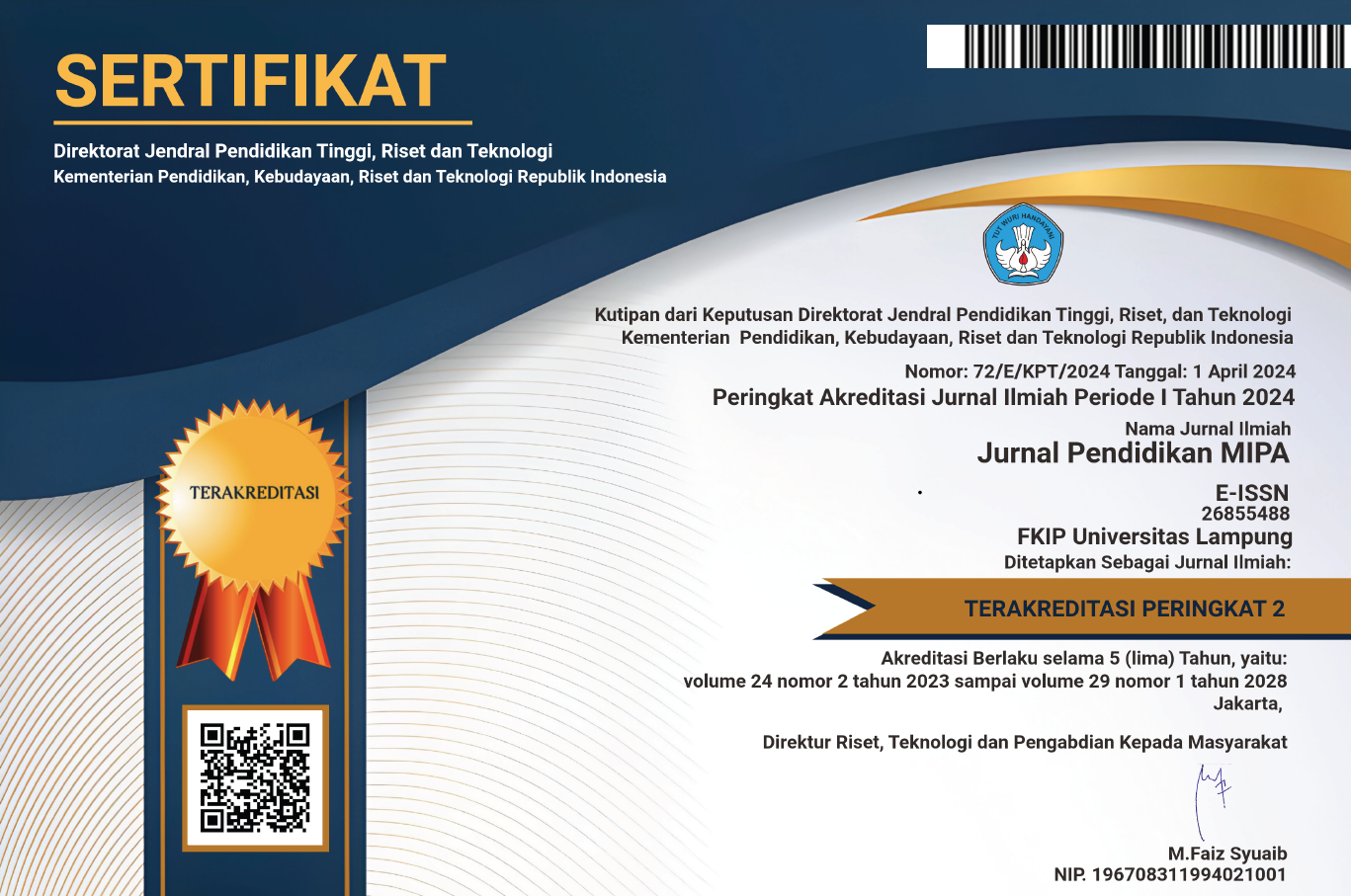EduChem Hidrokarbon: A Green Chemistry Based Discovery Learning Media on Hydrocarbon Nomenclature
 Country:
Country:
(1) Mulawarman University, Indonesia
(2) Mulawarman University, Indonesia
(3) Mulawarman University, Indonesia
This study aims to develop Educhem Hydrocarbons based on Green Chemistry using the Discovery learning learning model on the nomenclature of hydrocarbon compounds. This study applies the Research and Development (R&D) method with the Brog and Gall approach. The research sample amounted to 44 students of class XI. The instruments used are validation questionnaires, student response questionnaires, pretest posttest questions and student activity observations. The results show that the learning media is declared valid with a validity value of 93.93%, practical with a small scale of 89.76% and 93.53% of a large scale. The effectiveness of the media based on the value of small-scale N-gain 0.71 and large-scale N-gain 0.73. The effectiveness based on student activities on a small scale is 90.71% and a large scale is 92.99%. This shows that the Educhem Hydrocarbons learning media based on Green Chemistry is declared suitable to be used as a learning resource on the subject of nomenclature of hydrocarbon compounds.
Keywords: learning media, discovery learning, green chemistry, hydrocarbon nomenclature.
Andrews, J. D. (1984). Discovery and expository learning compared: Their effects on
independent and dependent students. The Journal of Educational Research, 78(2),
-89.
Brom, J. M. (2018). Orbital Configuration: Terms, States, and Configuration State
Functions. Journal of Chemical Education, 95(9), 1592–1600. https://doi.org/10.1021/acs.jchemed.8b00187
Evans, E. D. (2015). The Effects Of Achievement Motivation And Ability Upon Discovery
Learning And Accompanying Incidental Learning Under Two Conditions Of The
Effects . Of Achievement Motivation And Ability Upon Discovery Learning And Accompanying Incidental Learning Under Two Conditions Of Incentive-Set, 671(May 2016). https://doi.org/10.1080/00220671.1967.10883474
Fourches, Denis, and Jeremiah Feducia. (2018). “Student-Guided Three-Dimensional Printing Activity in Large Lecture Courses: A Practical Guideline.” Journal of Chemical Education. http://pubs.acs.org/doi/10.1021/acs.jchemed.8b00346.
Grobmann, Nadine, and Matthias Wilde. (2019). Experimentation in Biology Lessons : Guided Discovery through Incremental Scaffolds Incremental Scaffolds. International Journal of Science Education 0(0): 1–23.
Hake, Richard. (1998). Interactive-Engagement versus Traditional Methods: A Six Thousand-Student Survey of Mechanics Test Data for Introductory Physics Courses. American Journal of Physics 66(1): 64–74.
Ijay, S. (2021). “The Effectiveness of Using Learning Media 3D Pop-Up Chemistry Assisted by Project Based Learning (PjBL) Learning Model Against Student Learning Outcomes on the Subject of Colloid Systems in SMA Negeri 12 Samarinda.” 11(2): 45–50.
Irsalina, A., & Dwiningsih, K. (2018). Practicality Analysis of Developing the Student Worksheet Oriented Blended Learning in Acid Base Material. JKPK (Jurnal Kimia Dan Pendidikan Kimia), 3(3), 171.
Karpudewan, M., Roth, W. M., & Ismail, Z. (2015). The effects of “Green Chemistry” on secondary school students’ understanding and motivation. The Asia-Pacific Education Researcher, 24(1), 35-43.
Khairunnisah. (2018). Pengembangan Media Scrabble Hydrocarbon Chemistry Dengan Menggunakan Model Pembelajaran PBL Pada Pokok Bahasan Hidrokarbon di SMK Negeri 2 dan SMK Muhammadiyah 3 Samarinda. In Program Magister Pendidikan Kimia Universitas Mulawarman. Program Magister Pendidikan Kimia Universitas Mulawarman.
Kistner, S., Vollmeyer, R., Burns, B. D., & Kortenkamp, U. (2016). Computers In Human Behavior Model Development In Scienti Fi C Discovery Learning With A Computer- Based Physics Task. Computers In Human Behavior, 59, 446–455. https://doi.org/10.1016/J.Chb.2016.02.041
Kunsting, J., Kempf, J., & Wirth, J. (2013). Enhancing Scientific Discovery Learning Through Metacognitive Support, 38, 349–360. https://doi.org/10.1016/J.Cedpsych.2013.07.001
Munandar, H., & Jofrishal, J. (2017). Analisis Pelaksanaan Pembelajaran Kimia Di Kelas omogen (Studi Kasus Pembelajaran Kimia Di Sma Negeri 11 Banda Aceh). Lantanida Journal. https://doi.org/10.22373/lj.v4i2.1882
O’Brien, M. (2016). Creating 3-Dimensional Molecular Models to Help Students Visualize Stereoselective Reaction Pathways. Journal of Chemical Education, 93(9), 1663–1666. https://doi.org/10.1021/acs.jchemed.6b00250
Penny, M. R., Cao, Z. J., Patel, B., Sil Dos Santos, B., Asquith, C. R. M., Szulc, B. R., Hilton, S. T. (2017). Three-Dimensional Printing of a Scalable Molecular Model and Orbital Kit for Organic Chemistry Teaching and Learning. Journal of Chemical Education, 94(9), 1265–1271. https://doi.org/10.1021/acs.jchemed.6b00953
Riduwan. (2007). Rumus Dan Data Dalam Analisis Statistik Untuk Penelitian. Bandung: Alfabeta.
Robertson, M. J., & Jorgensen, W. L. (2015). Illustrating Concepts in Physical Organic Chemistry with 3D Printed Orbitals. Journal of Chemical Education, 92(12), 2113 2116. https://doi.org/10.1021/acs.jchemed.5b00682
Sudiana, I. K. S., Suja, I. W., & Mulyani, I. (2019). Analisis Kesulitan Belajar Kimia Siswa Pada Materi Kelarutan dan Hasil Kali Kelarutan. Jurnal Pendidikan Kimia Indonesia. https://doi.org/10.23887/jpk.v3i1.20943.
Sugiyono. (2014). Metode Penelitian Bisnis. CV. Alfabeta.
Yonni, A, (2010). Menyusun Penelitian Tindakan Kelas. Familia: Yogyakarta
Refbacks
- There are currently no refbacks.

This work is licensed under a Creative Commons Attribution-ShareAlike 4.0 International License.






